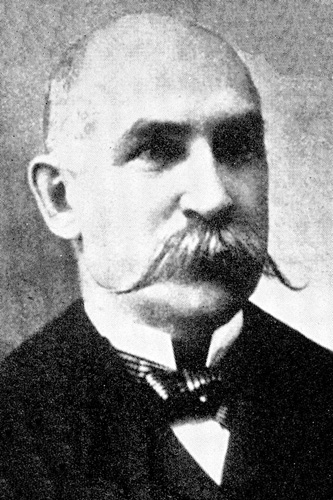 |
| JOHNSON COUNTY IAGenWeb Project |
Copyright 2003
By Bob Hibbs
Saturday
January 3, 2004
Saturday Postcard 226: Charles Schaeffer – Champion of UI’s Pentacrest
 |
Remnants
of “the red brick campus” are visible on the completed Pentacrest in this
aerial view looking west.
It was recorded shortly before 1949 when 1866 North Hall located north (right)
of Old Capitol between
Macbride and Jessup halls was demolished. The adjacent remnant 1895 Dental
Building was demolished in 1975.

U I Pres Charles Schaeffer |
By
Bob Hibbs
A
vigorous and tireless man with more the physical appearance a football guard
than an intellect, the University of Iowa’s seventh president, Charles
Schaeffer, played a pivotal role in creating in the midst of Iowa City the
institution of higher learning that exists today.
An
eight-inch handlebar mustache served as his trademark.
Although
virtually inconceivable today, he convinced the Iowa legislature and governor
to impose a state-wide property tax to support construction of UI buildings.
Although seemingly small at one-tenth of a mill, it represented a breakthrough
in UI funding during the decade it existed.
It
helped fund Schaeffer’s campus plan which envisioned the Pentacrest Campus
as it exists today.
Equally
inconceivable, the Iowa City council was convinced to give UI half of all its
park land, represented in the entire block south of United Methodist and St.
Mary’s Catholic churches. The site is now occupied by Van Allen Hall and a
biology annex along Iowa Avenue.
The
only other city park at the time was College Green, the central block-square
park still in use today. |
|
Equally
inconceivable, the Iowa City council was convinced to give UI half of all its
park land, represented in the entire block south of United Methodist and St.
Mary’s Catholic churches. The site is now occupied by Van Allen Hall and a
biology annex along Iowa Avenue.
The
only other city park at the time was College Green, the central block-square
park still in use today.
It
is probable the council had little legal framework for such a gift, but became
highly motivated by talk among legislators of moving the university to a more
central location in the state. The community’s strongly favorable impression
of Schaeffer made the gift politically feasible.
Schaeffer
advocated student athletics as an important element of a “fit body, fit
mind” philosophy, and as a method of connecting with alumni located away
from Iowa City. An early result was the first “Y” west of the Mississippi,
named Close Hall after is principal benefactor, opened in 1890 at Iowa Avenue
and Dubuque Street.
It
was the first major university structure financed privately and available for
sporting events, although its use encompassed far more than sports.
Another
result was purchase of ground for Athletic Park along the east bank of the
Iowa River where the first major UI athletics complex was created featuring
baseball and football fields, and later an adjacent men’s gym which still
later featured an indoor swimming pool addition.
Schaeffer’s
personable nature won him friends at all turns. He ran his own errands; he
wrote letters and drafted his speeches in longhand. He traveled the state
regularly and extensively, meeting with alumni, legislators and friends of the
university, winning new friends and influencing opinion.
Locally,
he and wife Evelyn, who became a well-known author, regularly held social
events in their large still-existing house located in the southeast quadrant
of the College-Johnson streets intersection across from College Green park.
The UI President’s House which serves that function today was built a decade
after Schaeffer’s death.
Schaeffer
was born in 1843 at Harrisburg, Penn., where his father was a third-generation
minister of German heritage. As a middle name, he was given his mother’s
family name, Ashmead, a family which traced its immigration to America to the
company of William Penn in 1682.
He
was educated thoroughly, first at the Germantown Academy attended by his
father and grandfather, then at Penn, Harvard, Gottingen (Germany, receiving a
PhD), and in Berlin and Paris. He was cited for gallantry during the Civil
War.
Schaeffer
joined the faculty of Cornell at age 26, spending the next 18 years there,
becoming head of the chemistry department in 1871, and later faculty dean,
before coming to Iowa City.
Schaeffer’s
sudden death in 1898 at age 55 shocked the local, state and alumni communities
since virtually everyone expected his leadership for another decade. Among his
last major ceremonial acts was groundbreaking for a new home for the
Collegiate Department, now known as the College of Liberal Arts.
It
is entirely fitting that the building now bears his name, Schaeffer Hall, and
anchors his completed plan for the central Pentacrest Campus.
Next
Saturday: Samuel Kirkwood, the
local man and Iowa governor.
Bob
Hibbs collects local postcards and researches history related to them. |